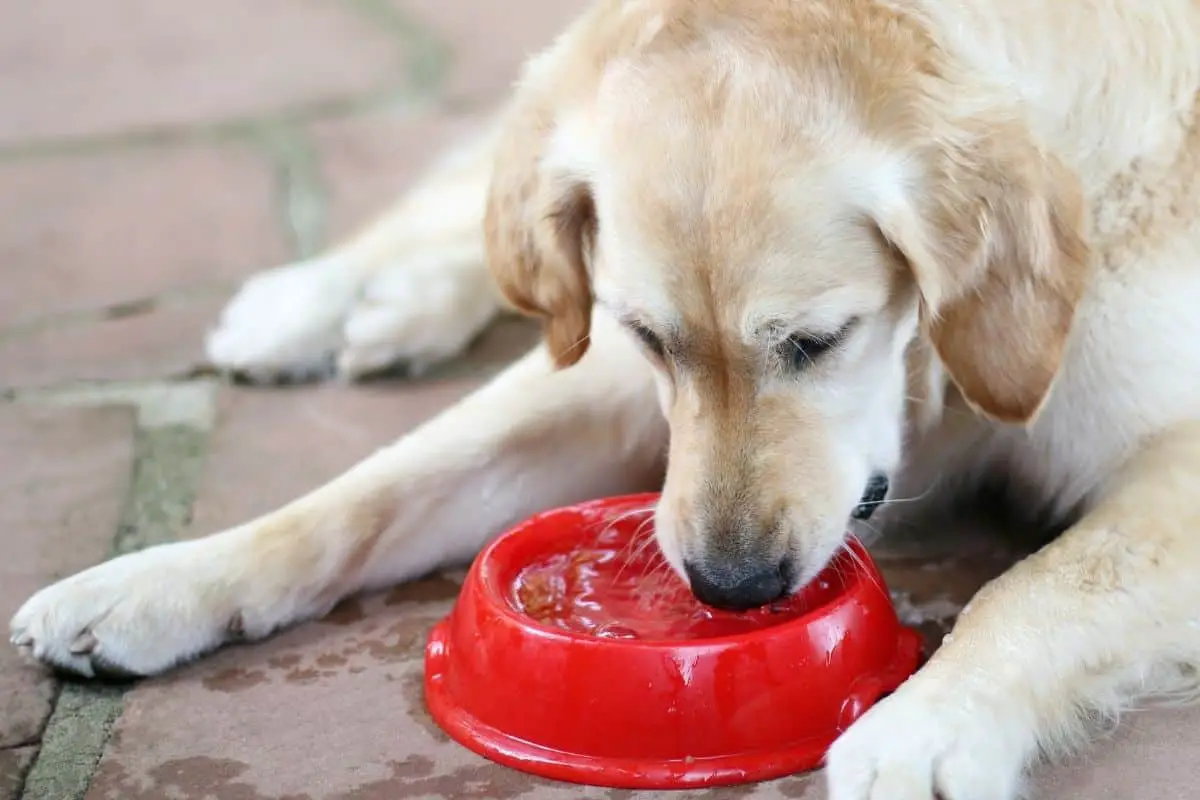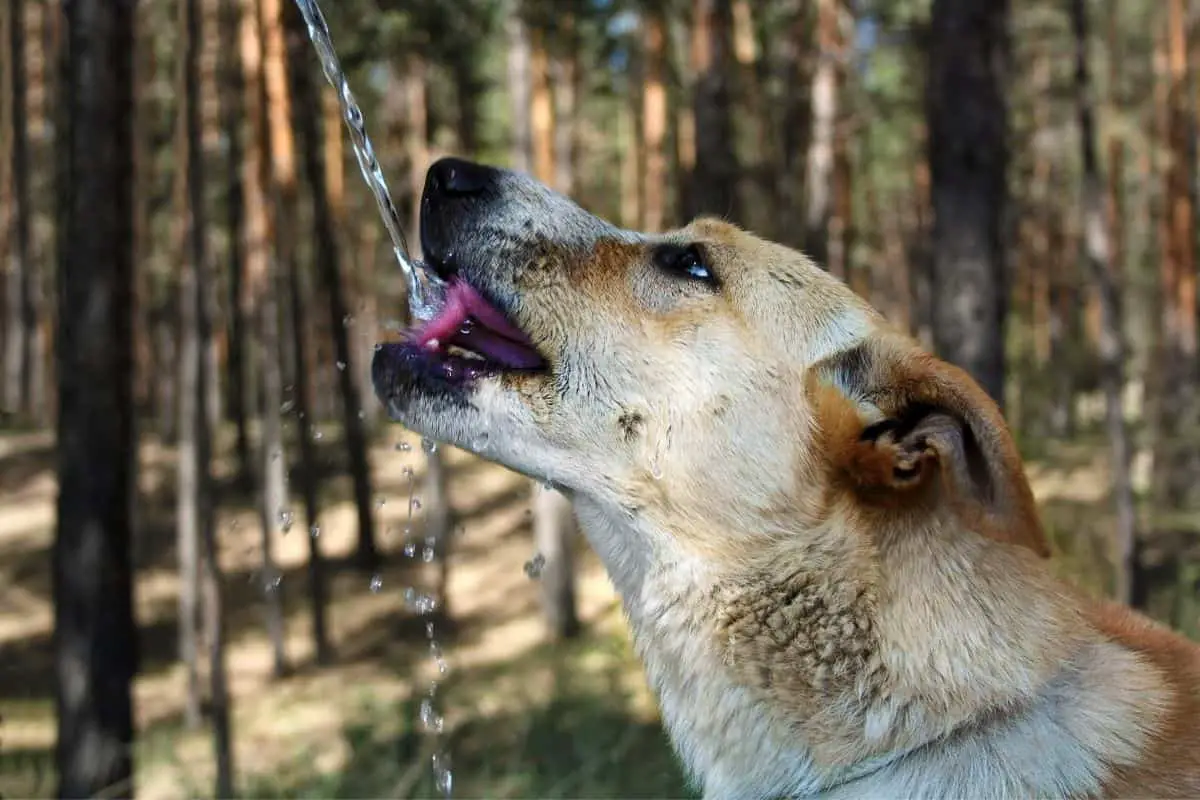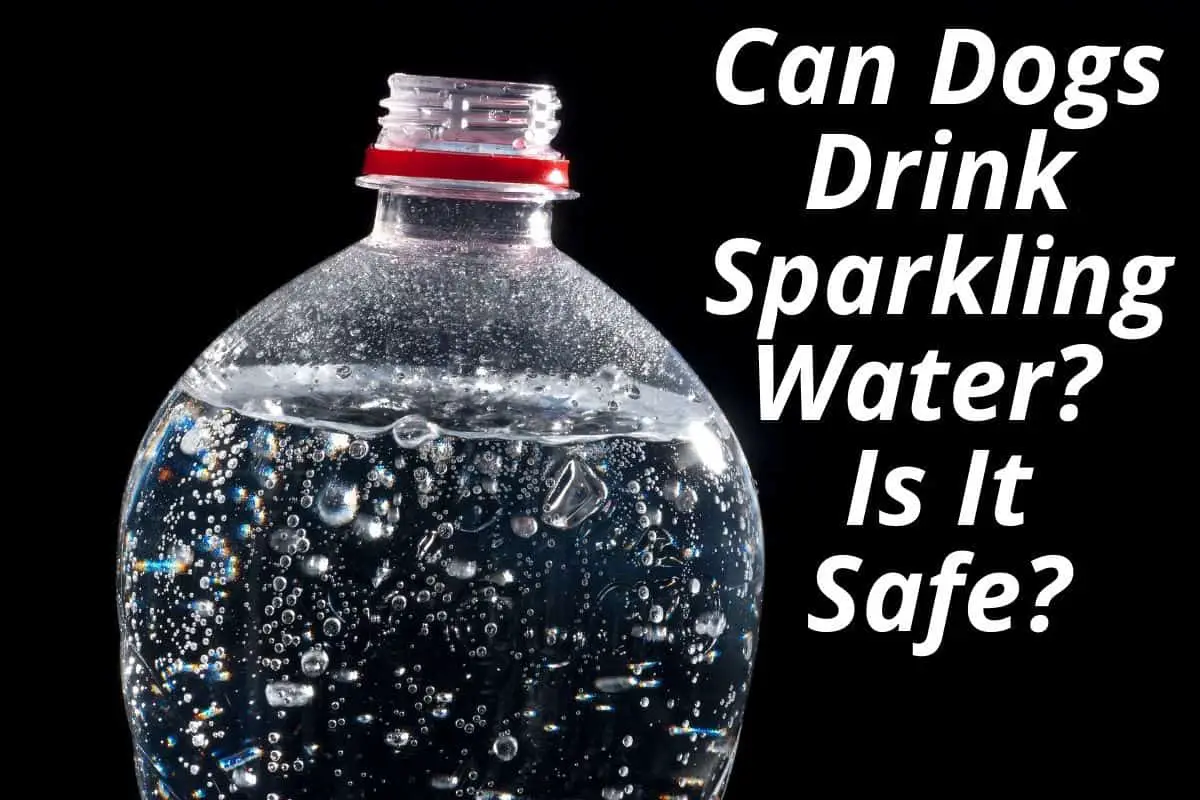This post contains affiliate links.
Dog owners must monitor their pet’s food and water intake carefully. Though you may be more worried about overfeeding, your dog’s hydration is just as crucial to their health. But what can you do if you notice they are not drinking enough water?
If your dog is dehydrated, rather than forcing them to drink water, try to understand the reason behind their lack of thirst. To keep your dog hydrated, always ensure they have a clean bowl, try to entice them with broth, introduce water-rich foods, and add wet food to their kibble.
This article will explore the relationship between your dog and water and how it is essential to their wellbeing. We will also discuss how much your dog should be drinking and what you can do if your dog refuses water.
Table of Contents
Why Your Dog’s Hydration Is So Important
Most dog owners will either leave ample water out for their dog all day or provide water for meals and after walks or exercise. Since humans will drink when they feel the need to, regulating their hydration based on their individual needs, we often expect dogs to do the same.
Many dogs instinctively can control their water intake, drinking enough to stay healthy daily. However, some dogs are unable to do so and will become over or under-hydrated as a consequence. As the dog owner, your job is to monitor your dog’s water intake and take steps where necessary.
Dehydration
If your dog is not drinking enough and becomes dehydrated, you will likely see them become lethargic and or begin to pant excessively. After a long walk or time spent outside on a hot day, it is essential to provide water to your dog to see them return to normal. However, in more severe cases, your dog may begin to show signs of urinary tract issues, such as kidney stones and even organ failure.
Dehydration can be brought on by:
- Over-exertion
- Extreme temperatures
- Diarrhea
- Underlying illness preventing the dog from drinking, such as pancreatitis
Overhydration
In terms of overhydration, this can occur when your dog is allowed to consume too much water. As mentioned above, some dogs do not have the instinct needed to monitor their water intake. By leaving a full bowl of water out at all times, you run the risk of over-hydrating your pet. This may lead to electrolyte imbalances, stomach bloating, and hyponatremia (water toxicity).
Overhydration can be brought on by:
- Allowing your dog access to too much water
- Bladder infection
- Underlying illnesses causing excessive thirst, such as diabetes
Hyponatremia
Hyponatremia can occur in people and dogs and is caused by an abnormally low sodium concentration in the blood. Though rare, it can happen when your dog is over-hydrated.
Sodium helps regulate the amount of water in and around your cells, and when your dog becomes overhydrated, the sodium will begin to dilute. Swelling in the cells may lead to more severe illnesses and even death; for example, any swelling in the brain can cause damage to the central nervous system.
Some signs that your dog may be in danger of water intoxication include but are not limited to:
- Confusion and loss of balance
- Lethargy
- Bloating
- Glassy eyes
- Vomiting
- An excess of saliva
- Seizures
- Struggles with breathing
Water intoxication can occur in your dog from drinking too much water as well as playing in the water for extended periods. As they play, they will often gulp large amounts of water down, leading to bloating and possible illness.
If you believe your dog has symptoms of hyponatremia, take them to the vet immediately. They will need an IV to deliver electrolytes and other drugs to help reduce any swelling.
You can prevent hyponatremia by monitoring how much water your dog is drinking and by limiting their time spent in the water. Give them lots of breaks in between play, letting them rest before entering the water once more.
Why Dogs Need Water
Just like humans, dogs require water far more than they need food. Though they can go for days without food, they will start to show signs of dehydration quickly if they are not given access to fresh water on a daily basis.
There are a few key reasons why your dog requires water, many of which are similar to the reasons humans need water. They include:
- Water facilitates daily bodily functions
- Water helps to flush toxins from the body
- It will aid in body temperature regulation
- It boosts a dog’s ability to smell
Essential Bodily Functions
Water is an essential aspect of all of our lives, and our dogs are no exception. It is responsible for maintaining your dog’s metabolic processes, supports food digestion, and aids in overall health. Dogs need water to think, run, eat, sleep, and breathe, and without it, their bodies would begin to shut down quickly.
Flushing Toxins
Like humans, dogs are as much as 80% water and require proper hydration to ensure adequate blood flow. As white blood cells move around the body, they also flush out toxins from their system. Without water, your dog’s blood circulation would suffer, and toxins would begin to build up, most often in the kidneys. Rather than being flushed out, these toxins would be absorbed back into their bloodstream, causing several health issues.
Temperature Regulation
As we drink cold water on a hot day, dogs use water to stay cool when temperatures go up. As they get hot, dogs will begin to pant, which is the act of expelling water through respiration. They will then drink water to replace the water lost. You should always ensure your dog has enough water on hot days and when walking out in the heat.
Smelling Power
It is not uncommon in extreme temperatures (both hot and cold) to see your dog’s nose become dry. This is a sign of dehydration and will affect how your dog interacts with the world. Water is essential for keeping your dog’s nose moist, which helps them detect even the smallest scents.
How Much Water Should a Dog Drink a Day?
You will see the recommended guidelines for how much a typical adult dog should be drinking in the table below. The information is based on the dog’s size and weight, the weather, and what kind of food they eat. This is not a definitive guide, and amounts may vary depending on breed and daily activity level. Always consult your vet if you are unsure of how much water to give your dog.
|
Dog Size |
Temperature |
Dry Food |
Wet Food |
|
5kg (11.02lb) |
Over 20°C/68°F |
250-500ml (8.45-16.91oz) |
100-250ml (3.38-8.45oz) |
|
Eg. Chihuahua |
Under 20°C/68°F |
200-250ml (6.76-8.45oz) |
25-50ml (0.85-1.69oz) |
|
10kg (22.05lb) |
Over 20°C/68°F |
500ml-1Lt (16.91-33.81oz) |
200-500ml (6.76-16.91oz) |
|
Eg. Beagle |
Under 20°C/68°F |
400-500ml (13.53-16.91oz) |
50-100ml (1.69-3.38oz) |
|
20kg (44.09lb) |
Over 20°C/68°F |
1-2Lt (33.81-67.63oz) |
400ml-1Lt (13.53-33.81oz) |
|
Eg. Border Collie |
Under 20°C/68°F |
800ml-1Lt (27.05-33.81oz) |
100-200ml (3.38-6.76oz) |
|
30kg (66.14lb) |
Over 20°C/68°F |
1.5-3Lt (50.72-101.44oz) |
600ml-1.5Lt (20.29-50.72oz) |
|
Eg. Boxer |
Under 20°C/68°F |
1.2-1.5Lt (40.58-50.72oz) |
150-300ml (5.07-10.14oz) |
|
40kg (88.18lb) |
Over 20°C/68°F |
2-4Lt (67.63-135.26oz) |
800ml-2Lt (27.05-67.63oz) |
|
Eg. German Shepherd |
Under 20°C/68°F |
1.6-2Lt (54.10-67.63oz) |
200-400ml (6.76-3.38oz) |
As you can see, in warmer weather, larger breeds require almost twice the amount of water that they do in colder months. Another major factor in how much your dog should be drinking is based upon their diet. The table clearly shows that dogs eating a purely dry kibble diet require far more water than dogs on a wet food diet.
What If Your Dog Is Not Drinking Water?
There are a few reasons why your dog may not be drinking water. These include but are not limited to:
- Inactivity can lead to your dog not feeling thirsty, and they may not be drinking as much as usual.
- In new places where the water may not smell or taste the same, it is not uncommon to see dogs refusing to drink.
- Illnesses like diabetes will affect your dog’s appetite and thirst, and they may stop eating and drinking when they feel bad.
- In their later years, many dogs will not eat or drink as much as they used to.
- Fear can be a significant factor for rescues, especially if they have had negative experiences eating and drinking.
- Gum or teeth issues could be causing your dog pain when they drink, leading them to avoid cool water.
- If their water bowl is unclean, your dog may refuse the water until you have cleaned the dish.
If your dog is not drinking water, it is crucial to understand how severe the issue is and what the cause may be. If they show signs of hyponatremia, you should take your dog to the vet right away to be checked and potentially put on an IV.
However, if this is new behavior and you catch it early enough, there are ways to encourage your dog to drink water. You should never try to force your dog to drink water, as this can lead to aggressive behavior or mistrust from your dog in the future. Instead, look for ways to encourage drinking, such as including water-rich treats into their diet.
How To Safely Rehydrate Your Dog
First, try to understand why your dog may not be drinking. Where your dog will likely race to the water bowl after a long walk on a hot day, they may not be as inclined to drink after a shorter walk on a cold day. The weather has a significant effect on our dogs, from their mood to their health. And in the colder months, your dog will not need as much hydration as in the summer.
Similarly, if you are traveling and at a new house, they may not feel comfortable eating and drinking in a new environment. For example, you may give your dog filtered water at home, and the new house is plain tap water. We may not smell or taste much of a difference, but your dog will be able to sense that the water is not the same and may not want to drink it.
You may or may not be able to determine the reason behind your dog’s lack of thirst, but there are things you can try to encourage them to drink. Try a few different ways and monitor your dog’s health. If they still refuse to drink, you will need to visit the vet.
Clean and Move the Water Bowl
You should be cleaning your dog’s water bowl daily. It is on or near the floor in most homes, and the bowl can often be filled with debris from household dust or your dog’s face. For example, a dog that may have been digging in the yard will bring dirt and soil inside on its snout that will disperse into their water when they drink. Clean the bowl daily and check for debris or dirt whenever you refill the water.
You can also try moving the bowl from its usual position. Try purchasing a stand to elevate the bowl from the ground, giving your dog better access. It could be that there is something in the usual spot that is off-putting to your dog, which you cannot see or smell. The new environment may help fix the issue.
Add Water to Their Kibble
In the table above, we showed how the amount of water a dog needs during the day could change drastically depending on its diet. Dogs that eat a purely wet food diet require far less water during the day than dogs that only eat dry kibble.
To encourage your dog to eat, try incorporating some water into their dry food. This will soften the food and hydrate it, allowing them to ingest water as they eat.
Use Ice as a Treat
Ice is an excellent way to get your dog to hydrate. The crunchy texture is pleasing to them, and ice cubes can be given to your dog in place of treats. Be careful when giving smaller dogs ice cubes, ensuring that they are not too big, which could be a choking hazard.
Some owners will freeze broth or the juices from canned tuna or chicken and use those as treats. The additional flavoring will be more appealing to your dog and should work to hydrate them as they chew.
Use Flavored Water
If your dog refuses to drink, try adding flavor to the water to tempt them into drinking. This may include sodium-free, all-natural broths added to their water bowl. Some broths are more potent than others and may need to be diluted before you can feed your dog. Always buy the kind of broth that contains no added salt, and check the package for harmful ingredients, such as onion and garlic.
Bring Water With You When You Travel
If you notice that your dog will not drink from water fountains or bowls in unfamiliar places, try bringing a bottle of water from home when you travel. Fill up a bottle (or a few if you will be gone a while) and bring water with you, along with their water bowl. This should prevent them from being suspicious of different smelling water.
Get a New Bowl
The material of your dog’s bowl may slightly change how food and water taste to your dog. The smell may also play a big factor in their lack of thirst. Try using a new bowl with a different material to see if that encourages your dog to drink. Always clean the bowl beforehand.
Give Your Dog Wet Food
Wet food is more hydrating than kibble, and if your dog is not drinking, try giving them wet food instead or mix it into the kibble. This will help them hydrate while they eat, and wet food is typically more appealing than kibble. However, if your dog is not eating in addition to refusing water, you should take your dog to the vet immediately.
Final Thoughts
If you are considering forcing your dog to drink, chances are they have been refusing water and may be dehydrated. Before attempting to force them, which may have negative results, try to determine why your dog is not drinking, as it could be the result of an injury or unknown illness.
Some dogs do not drink dirty water or unfamiliar water. Always ensure they have a clean bowl, bring water with you when you travel, and try giving them broth or water-rich foods if they are still refusing to drink. If the behavior continues, consult with your vet.
Related Articles
- Can Dogs Drink Sparkling Water? (Is It Safe?)
- What Can Dogs Drink Besides Water? (We Ask the Experts)
- Can a Dog Go 8 Hours Without Water?
- Can Dogs Drink Coconut Water? Let’s Find Out!
- Can Dogs Drink Distilled Water? Let’s Find Out
- How Long Can Dogs Go Without Water? (We Ask the Experts)
- My Dog Drank Pool Water: Here’s What To Do About It
- Dog Water at Night – When To Cut Them Off
Sources
- Cesar’s Way: Hydrate Your Hound
- Mayo Clinic: Hyponatremia
- Centennial Animal Hospital: Water Intoxication in Dogs
- Tractive: Your dog won’t drink water? Top 5 reasons why & what you can do
- Vet Emergency Group: Reasons Why Your Dog Won’t Drink Water
Mrdogfood.com is a participant in the Amazon Services LLC Associates Program, an affiliate advertising program designed to provide a means for sites to earn advertising fees by advertising and linking to Amazon.com. We also participate in other affiliate programs which compensate us for referring traffic.




